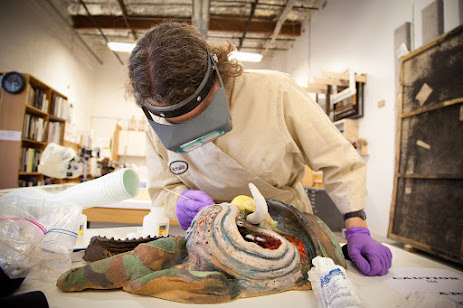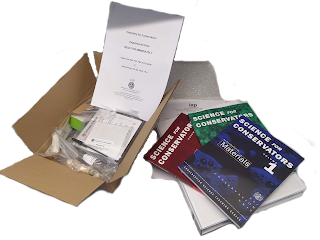Chemistry For Conservators 01
‘Chemical processes underlie many of the practices and techniques used in conservation. From environmental control in preventative conservation to practical conservation and restoration, chemical interactions take place between the object and the outside world. These interactions may be harmful or benign, and need to be understood in order that they be controlled’. (Introduction, Chemistry for Conservators IAP)
Everything is going to fall apart. Entropy’s gonna git ya!
At least, that often felt like the central theme of the ‘Chemistry for Conservators’ course I undertook in 2021. The good news is the course also tells you how to, like, stop that happening.
As a Curator I’ve been fascinated with how objects are
preserved (‘for future generations to enjoy’ is how that phrase usually ends
when writing funding bids), which is just as well as looking after the
precious things is kind of fundamental to the job. This art, which is actually a
science, is called... Conservation.
PAY ATTENTION AT THE BACK
 |
| It's not much of an exaggeration to say that all photos of Conservators at work are the same. Here's a typical one I nicked from the San Francisco Museum of Modern Art. |
PREVENTATIVE
This is the most basic level of conservation - preventing objects being
damaged, or mitigating their further deterioration, in all typical museum
scenarios (display, storage, transport, loan and so on)
Even the most disinterested museum bod working with
collections will pick up the rough basics of preventative conservation – Light
Bad, Moisture Bad, Cold Bad, Heat Bad, Sticky-fingered-children Bad etc.
Often this knowledge manifests through basic common sense –
don’t put paper objects in direct sunlight if you don’t want them to fade to nothing, don’t
leave metal objects out in the rain, etc etc, and this knowledge, combined with
a healthy curiosity to understand collections, is often enough to successfully
negotiate day-to-day care of the special things.
REMEDIAL
While preventative conservation is performed by all Curators daily, and often
unconsciously given how embedded in the role looking after the special things
is, remedial conservation is generally performed by your actual Conservators
with all the training and that.
Remedial conservation is performed when an object has
deteriorated to a point where it cannot be protected without intervention - e.g.
the frayed, splitting spine of a book may be repaired to allow it to be
(carefully, natch) handled without causing further damage.
RESTORATIVE
The most hardcore form of conservation. Whereas remedial conservation aims to
stabilise objects in their current condition, restorative conservation returns
an object to an earlier state, such as by removing yellowed varnish and soot
deposits or retouching damaged areas of a painting.
Because it is the most invasive form of conservation (issues
of conservation vs restoration are perennial discussions in many heritage
forums), general practice is that restorative conservation is performed only
when there is a particular reason to do so - usually because deterioration has
caused our understanding of an object’s significance or function to be
compromised – e.g. reassembling a broken statue or returning a historic machine
to working order to demonstrate its operation.
My hobbies of collecting ancient toy trains, and the protracted restoration of the family tractor, have given me some experience of all three levels of conservation - albeit very much in a monkey-with-a-typewriter sense. This experience has proved extremely useful on two fronts; 1) our toy trains are nice and protected, and 2) it's taught me enough about conservation to understand just how little I know about conservation. Hence the course.
SO WHAT DO CURATORS DO?
Elements of conservation work can be performed by a lay Curator – mostly in the preventative mode and often through simple measures such as endeavouring to store objects in a stable environment and handling with appropriate equipment. For instance touching a metal object with unwashed hands leads to more rapid corrosion than you might think, even washed hands being full of all sorts of oils and general mank. This is why you’ll see Curators wearing those garish purple nitrile gloves when fondling the special things on TV. It’s certainly not ‘cos they’re cool – far from it! Conservation-grade rubber gloves are tight, sweaty ‘orrible things, but they’re better than getting your grease all over stuff.
 |
| From the dawn of my career (and loveable mop-top phase), Curators conserve a pair of Women's Land Army breeches. How can you tell we're Curators? Why, because of the silly purple gloves of course! |
To paraphrase Hippocrates;
‘Practice two things in your dealings with old stuff: either help or do not harm the precious things’.
The importance of Curators understanding the principles of
conservation can’t be overstated – indeed quite a bit of current curatorial
work can involve undoing the well-meaning but misguided efforts of earlier
generations of Curators going rogue and using their initiative. For instance a
previous Curator at one of the first museums I worked at had decided the best
way to prevent deterioration of a pile of paper artefacts was to… run them
through a laminator. Cheers.
This is why for anything other than the most basic
conservation work, you call in an expert trained Conservator. There are many
different flavours of conservator, specialising in working with paper, wood,
textiles, art, ceramics, metal, buildings, etc etc etc…
Larger establishments, such as the British Museum (Plunderbirds are Go. Ooh, satire. 😁), boast a
dedicated conservation team, but for most of us smaller and independent museums
we rely on seeking help from freelance Conservators, often through the directory
of ICON, the Institute of Conservation. Check 'em out HERE.
The services of a Conservator do not come cheap and often
can only be employed through a discrete funding bid, but considering the level
of knowledge and skill required they are worth every penny!
WHERE DO I COME IN?
I did/do want to be a Conservator. Don’t laugh.
Considering myself to have a technical brain, albeit housed
in an arts graduate body alongside a large amount of cake, over my career
I’ve become more and more interested in the scientific processes behind why
objects deteriorate and how this can be mitigated.
Always on the lookout for CPD, in an ideal world I’d love to
study for a Conservation MA though costs and the demands of a full-time job
prevent that. And I now go to bed far too early to be a self-respecting student.
A COURSE, OF COURSE
Scouting about for alternative courses to at least give a flavour
of conservation skills I came across the ‘Chemistry for Conservators’
run by International Academic Projects. This four month remote-learning course
is aimed at museum professionals who work with collections but have rusty
GCSE/A-Level science. Me, basically!
The course isn’t designed to let you begin merrily conserving things left, right and centre. What it does do is provide a thorough grounding in the scientific principles behind the deterioration and conservation of artefacts, so next time you’re at a party and conversing with a Conservator you can at least half-way understand them and perhaps even offer your own contribution to proceedings which isn’t just burbling something about re-aligning warp coils…
'Chemistry for Conservators' isn’t the cheapest, but after signing up you do receive a pleasingly large array of course work, text books and an exciting box full of dangerous chemicals.
 |
| It's Christmas! But in Feb 2021. I call it... Februarychristmass! |
I’ll chronicle my experiences of the four-month course and what I learned over future blogs, but in the meantime why not have a look at the course page yourself HERE.
Spoiler - the course involved an awful lot of this...
 |
| So many words to stick in my brain via my eyes |


Comments
Post a Comment